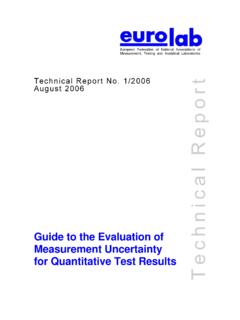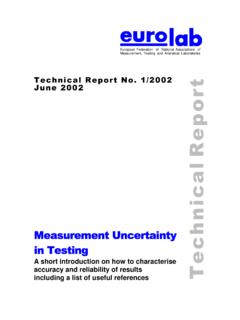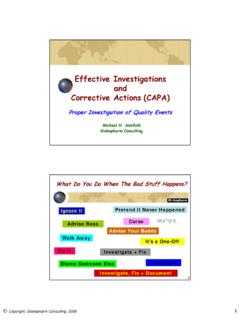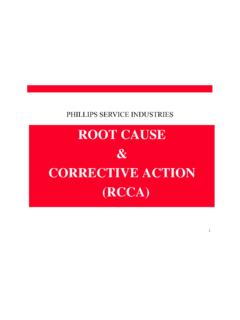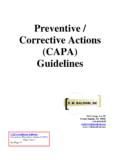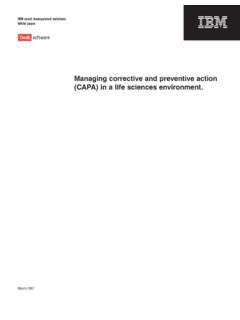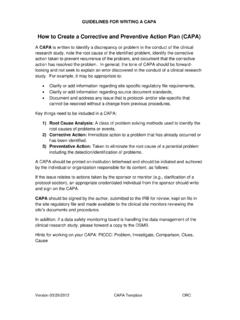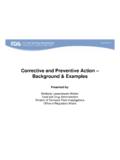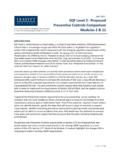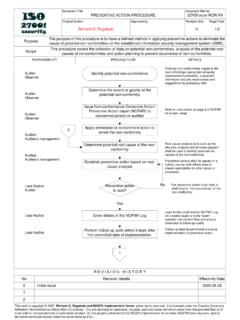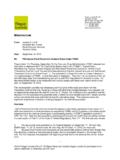Transcription of CORRECTIVE AND PREVENTIVE ACTION - EUROLAB
1 EUROLAB Cook Book Doc No. June 2013 1 CORRECTIVE AND PREVENTIVE ACTION Background of terms CORRECTIVE and PREVENTIVE actions are powerful tools of continuous improvement in quality management systems such as ISO 17025 and ISO 9001. CORRECTIVE ACTION is an activity that should be used to stop the re-occurrence of non-conformities. PREVENTIVE ACTION is an activity that should give the opportunity to prevent potential non-conformities. CORRECTIVE ACTION has to be initiated when a problem exists. If such a problem does not exist but there is a possibility for it, PREVENTIVE ACTION has to be taken.
2 Remedial ACTION can easily be confused with CORRECTIVE ACTION . Remedial ACTION is taken to rectify the mistake. CORRECTIVE ACTION is an ACTION to eliminate defined non-conformities. Example: To recall a test report and make necessary changes is a remedial ACTION because making changes in the report does not help to prevent re-occurrence of non-conformities. CORRECTIVE and PREVENTIVE actions are defined in ISO 17025 article and , respectively. Identification and classification of non-conformities Identification of non-conformities is the key process and should be well defined in quality systems. Non-conforming testing and/or calibration work is described in article of ISO 17025.
3 Other non-conformities should also be detected and classified from customer complaints, customer feedbacks, internal audits, external audits and any deviation during the maintenance of the quality system. It should always be considered whether the collected data is useful for the purpose. If data is collected and classified correctly, this activity will help to identify the problems clearly. During the classification process, the priority and significance of non-conformities should be evaluated. EUROLAB Cook Book Doc No. 12 2 April 2012 The audit, client or normative criteria is assessed against the evidence found by the client, the internal/external auditor, or laboratory staff.
4 The assessment can conclude that there are several different cases: CRITERIA EVIDENCE ASSESSMENT FINDING STRONG POINT: The evidence shows an OVERFULFILMENT of the criteria NO REMARK: The evidence shows a FULFILMENT of the criteria WEAK POINT: The evidence shows that IN THE FUTURE there would be an UNDERFULFILMENT. Include a COMMENT in the report DEVIATION/NON-FULFILMENT: There is an UNDERFULFILMENT: - Severe underfulfilment: NONCONFORMITY - slight underfulfilment: OBSERVATION Possible IMPROVEMENT ACTION IMPROVEMENT ACTION OR PREVENTIVE ACTION CORRECTION &/OR CORRECTIVE ACTION EUROLAB Cook Book Doc No.
5 June 2013 3 Process steps of CORRECTIVE ACTION - Cause analysis, root cause ISO 17025 Standard indicates that the CORRECTIVE ACTION process starts with a cause analysis. Cause analysis is the important and most difficult step in the process. Any kind of mistake in this step may cause the implementation of wrong CORRECTIVE ACTION and does not avoid re-occurrence of non-conformities. The initial step of cause analysis is organizing a CORRECTIVE ACTION team consisting of laboratory staff familiar with the problem. All potential causes should be evaluated by brainstorming discussions by the CORRECTIVE ACTION team in order to define the root cause The team should consider all circumstances related to the problem such as personnel, equipment, chemicals, training etc.
6 But they should always remember that the primary aim is to find the root cause. - Analyzing non-conformities effects and needs for ACTION The impact of non-conformities on laboratory work should be analyzed carefully. The possibility of recurrence and end effect on a routine procedure should be determined. Some of the non-conformities may not have the chance of recurrence or no effect to the procedures. The CORRECTIVE ACTION Team should decide what kind of ACTION has to be taken. CORRECTIVE actions can be implemented either during one special event or during recurrent events according to the severity and the priorities of non-conformities.
7 - Selection and implementation of CORRECTIVE actions The laboratory should implement CORRECTIVE actions after the decision of the CORRECTIVE ACTION Team. Necessary conditions for CORRECTIVE ACTION should be clearly defined. The laboratory management should be confident about the effectiveness and the performance of the CORRECTIVE ACTION . - Monitoring of CORRECTIVE actions The result of the CORRECTIVE actions should be recorded and monitored for determining the effectiveness of the CORRECTIVE actions. Monitoring should verify the successful completion of the identified actions and assess the effectiveness of the actions taken.
8 Monitoring of reoccurrences of non-conformities after the implementation of CORRECTIVE actions is one of the key performance indicators for CORRECTIVE ACTION process. - Additional audits ISO 17025 requires additional audits if identified non-conformities cause serious doubts about a laboratory s compliance with standards, its own policies and its own procedures. Process steps of PREVENTIVE ACTION - Data collection for potential non-conformities The laboratory should determine the objectives of processes or activities in their quality system and analyze the critical factors which effect the achievement of these objectives.
9 A PREVENTIVE ACTION team should be organized and the adverse effects to the processes or activities should be carefully evaluated and classified according to their severity and priority. EUROLAB Cook Book Doc No. 12 2 April 2012 - Cause analysis for root cause for potential non-conformities Impact assessment of the factors influencing the processes and activities should be undertaken. The causes have to be determined and the root cause of potential non-conformities should be defined by the PREVENTIVE ACTION team. - Selection and implementation of PREVENTIVE actions The laboratory should implement actions to prevent the defined potential non-conformities.
10 These actions should detect and prevent adverse effects on laboratory performance before they happen. - Monitoring of PREVENTIVE ACTION The laboratory should monitor the results of PREVENTIVE actions to reduce the possibility of occurrence of defined non-conformities. Preventative ACTION processes should be reconsidered if a non conformity happens subsequently. - Records of CORRECTIVE and PREVENTIVE actions Records should be kept of all steps of CORRECTIVE and PREVENTIVE actions. - Evaluation of CORRECTIVE and PREVENTIVE actions The laboratory shall ensure that a quality team evaluates periodically all CORRECTIVE and PREVENTIVE actions that have been performed and their results.


